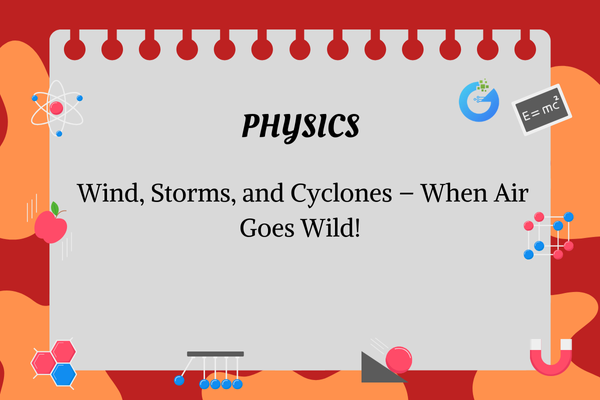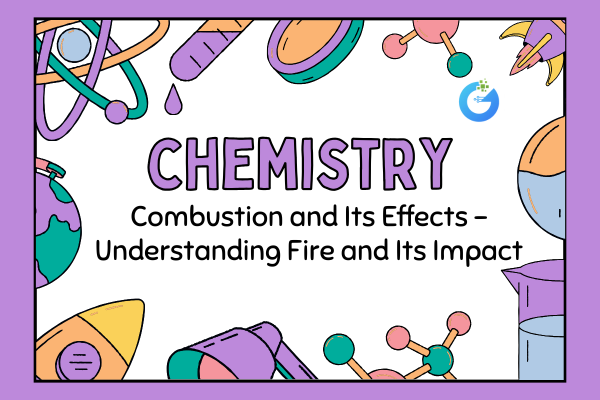Introduction – What Happens When the Wind Gets Angry?
Have you ever felt the wind suddenly pick up before it starts raining? Or seen tree branches swing wildly during a thunderstorm? These are signs that something powerful is happening in the atmosphere. Wind, storms, and cyclones are all natural events caused by air movement—and they can range from a light breeze to fierce, swirling giants that affect entire regions. Let’s explore how these wild movements of air happen and what they mean for us!
expert-led Physics classes – visit our website to learn more
What Is Wind?
Wind is just moving air. It happens because of differences in temperature and pressure in the atmosphere. When the sun heats up the Earth, some areas get warmer than others. Warm air rises (because it’s lighter), and cooler air rushes in to take its place. This movement of air is what we call wind.
During the day, land heats up faster than water. So, cool air from the sea moves toward the land creating a sea breeze. At night, the land cools faster than the sea, and the wind direction reverses—this is called a land breeze.
What Causes Storms?
Storms happen when there is a sudden and violent change in the weather, often involving strong winds, rain, thunder, and lightning. They are caused by rapid rising of warm, moist air. As the warm air rises, it cools and forms thunderclouds. These clouds may bring heavy rain and lightning, and the fast-rising air causes gusty winds.
Some common types of storms include:
- Thunderstorms – Caused by rapid upward movement of warm air; often brings lightning and thunder.
- Dust Storms – Strong winds lift large amounts of dust and sand into the air, reducing visibility.
What Are Cyclones?
A cyclone is a huge storm system that forms over warm ocean water. It involves a large, low-pressure area with very strong winds spiraling inward. Cyclones bring heavy rain, powerful winds, and huge sea waves. In India, these are often called tropical cyclones.
Here’s how a cyclone forms:
- Warm ocean water heats the air above it.
- The warm, moist air rises and forms clouds.
- More air rushes in to fill the low-pressure area, creating a spinning motion due to the Earth’s rotation.
- As the cyclone grows, it can become extremely strong and dangerous.
Cyclone vs. Tornado – What’s the Difference?
While both involve spinning winds, a cyclone is much larger and forms over oceans, lasting several days. A tornado is smaller, forms over land, and lasts a few minutes—but can still be extremely destructive.
| Feature | Cyclone | Tornado |
| Size | Hundreds of kilometers wide | A few hundred meters wide |
| Duration | Several days | Few minutes to an hour |
| Location | Over warm ocean water | Over land |
| Shape | Spiral cloud system | Funnel-shaped cloud |
Effects of Cyclones – Why Are They So Dangerous?
Cyclones can cause widespread destruction. Some major effects include:
- Strong Winds: Can uproot trees, damage buildings, and break power lines.
- Heavy Rainfall: Causes flooding in low-lying areas.
- Storm Surge: Cyclones push seawater onto the shore, flooding coastal villages and farmlands.
- Communication Disruption: Phone and internet lines often get damaged.
But with proper warnings and precautions, lives can be saved.
Core Concepts – What You Should Know
| Concept | Meaning | Example |
| Wind | Moving air due to pressure differences | Air blowing during a sea breeze |
| Storm | Sudden, violent weather with wind, rain, or snow | Thunderstorm with lightning |
| Cyclone | Large, rotating storm over ocean | Tropical cyclone hitting coastal area |
| Storm Surge | Rise in sea level due to cyclone winds | Coastal flooding during a cyclone |
| Tornado | Small, fast-spinning storm over land | Funnel-shaped storm in a field |
FAQs – Clearing Up Cyclone Confusion!
Q1: Why do cyclones mostly form over the sea?
Because they need warm ocean water to heat the air and create low pressure.
Q2: Can we predict cyclones before they hit?
Yes! Weather satellites and warning systems help track cyclones and warn people in advance.
Q3: What should we do during a cyclone?
Stay indoors, keep emergency kits ready, listen to weather updates, and move to safe shelters if advised.
Q4: Why are cyclones given names?
To easily identify and track them. It also helps in spreading awareness during emergencies.
Fun Facts About Wind and Cyclones
- A cyclone can release as much energy as 10,000 nuclear bombs during its lifetime!
- In the Southern Hemisphere, cyclones rotate clockwise. In the Northern Hemisphere, they rotate anticlockwise!
- Cyclones are named in advance by countries in the region. The name Amphan was given by Thailand and Tauktae by Myanmar.
- Tornadoes can spin at speeds of over 300 km/h—faster than a racing car!
Conclusion – Nature’s Power in the Air!
Wind, storms, and cyclones are powerful reminders of nature’s energy. While a gentle breeze can cool us down, a fierce cyclone can change entire landscapes. Understanding how these weather events form and behave helps us stay safe and prepare better. So, next time the wind whistles or thunder rolls, you’ll know there’s a science behind it—and it’s pretty amazing!
Would you like this turned into an animated presentation, quiz worksheet, or printable poster next?








